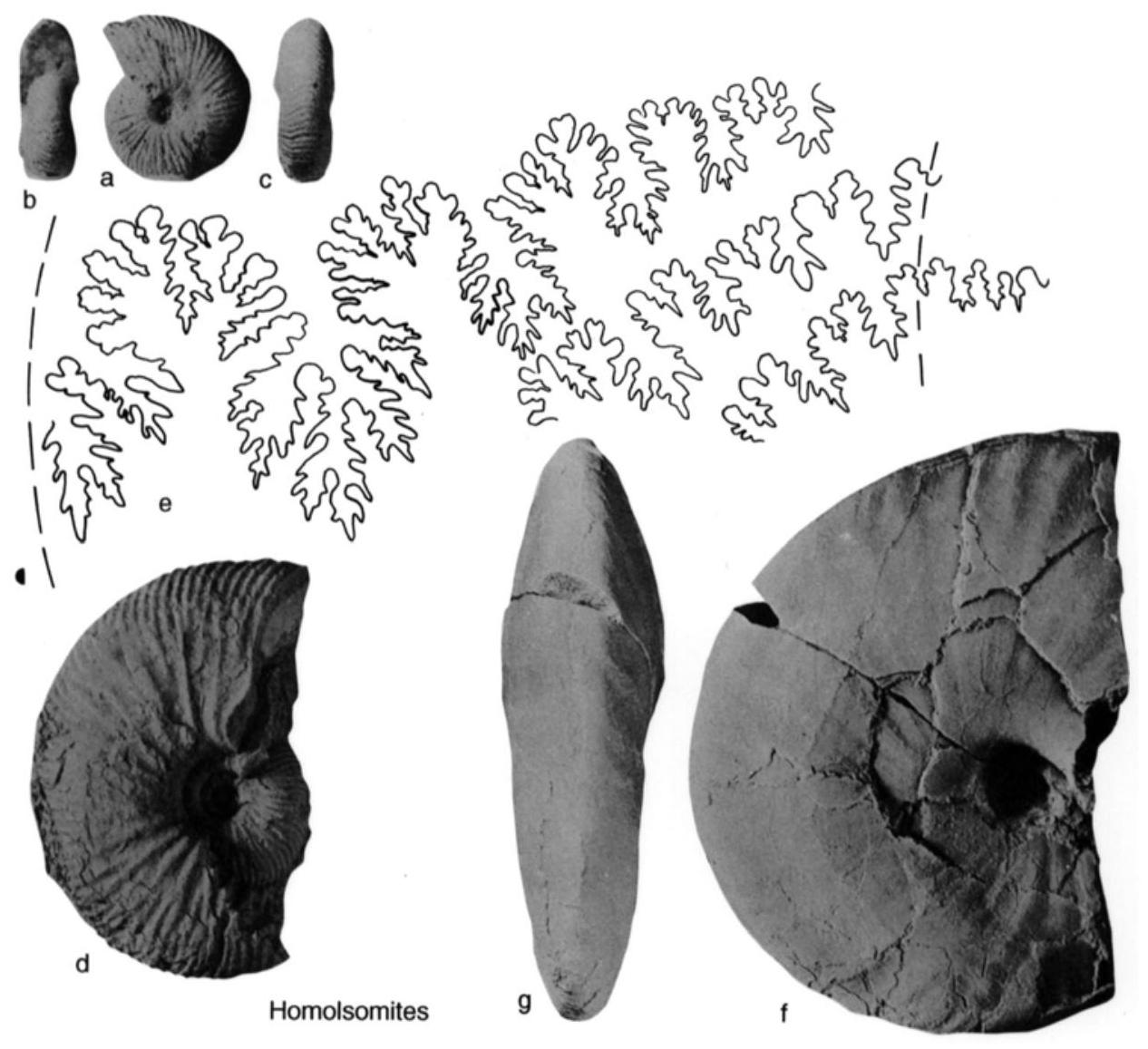Welcome to the Treatise on Invertebrate Paleontology!
Please enter a genera name to retrieve more information.

Homolsomites
Classification
Phylum:
Mollusca
Class:
Cephalopoda
Subclass:
Ammonoidea
Order:
Ammonitida
Suborder:
Ammonitina
Superfamily:
Perisphinctaceae
Family:
Polyptychitidae
Subfamily:
Polyptychitinae
Formal Genus Name and Reference:
Homolsomites CRICKMAY, 1930, p. 63
Type Species:
H. poecilotomus, OD, =Holcodiscus? stantoni MCLELLAN, 1927, Craspedites (Taimyroceras) and subsequently in Simbirskites (Craspedodiscus)
Images
(Click to enlarge in a new window)
Fig. 23a-e. *H. stantoni (McLellan), Upper Valanginian, Washington, a-c, holotype, microconch, X, d, e, inner whorls and suture of a macroconch, X (Imlay, 1960).—Fig. 23f, g. H. oregonensis (Anderson), Lower Hauterivian, Oregon, macroconch, X0.7 (Imlay, 1960).
Synonyms
Holcodiscus? Stantoni; Wellsia
Geographic Distribution
northern Siberia, British Columbia, northern Canada, California, Oregon, Washington
Age Range
Beginning Stage in Treatise Usage:
Lower Cretaceous (Upper Valanginian)
Beginning International Stage:
Valanginian
Fraction Up In Beginning Stage:
45
Beginning Date:
135.41
Ending Stage in Treatise Usage:
Lower Cretaceous (Lower Hauterivian)
Ending International Stage:
Hauterivian
Fraction Up In Ending Stage:
45
Ending Date:
129.86
Description
Similar to Tollia in its coiling, whorl section, size, and dimorphism, but ribbing and suture like those of Dichotomites; primary ribs dense, rectiradiate, dividing bidichotomously; secondary ribs projected on venter. Suture with long, narrow, and florid lobes. [Either late descendants of Tollia that have independently evolved the bidichotomous ribbing of Dichotomites or, more probably, yet another independent development of a Tollia-like morphology as found previously in such genera as Craspedites (Taimyroceras) and subsequently in Simbirskites (Craspedodiscus). Distribution limited, predominantly in the North Pacific Cordilleran Province.]
References
Museum or Author Information
Classification
Phylum:
Mollusca
Class:
Cephalopoda
Subclass:
Ammonoidea
Order:
Ammonitida
Suborder:
Ammonitina
Superfamily:
Perisphinctaceae
Family:
Polyptychitidae
Subfamily:
Polyptychitinae
Formal Genus Name and Reference:
Homolsomites CRICKMAY, 1930, p. 63
Type Species:
H. poecilotomus, OD, =Holcodiscus? stantoni MCLELLAN, 1927, Craspedites (Taimyroceras) and subsequently in Simbirskites (Craspedodiscus)
Images
(Click to enlarge in a new window)
Fig. 23a-e. *H. stantoni (McLellan), Upper Valanginian, Washington, a-c, holotype, microconch, X, d, e, inner whorls and suture of a macroconch, X (Imlay, 1960).—Fig. 23f, g. H. oregonensis (Anderson), Lower Hauterivian, Oregon, macroconch, X0.7 (Imlay, 1960).
Synonyms
Holcodiscus? Stantoni; Wellsia
Geographic Distribution
northern Siberia, British Columbia, northern Canada, California, Oregon, Washington
Age Range
Beginning Stage in Treatise Usage:
Lower Cretaceous (Upper Valanginian)
Beginning International Stage:
Valanginian
Fraction Up In Beginning Stage:
45
Beginning Date:
135.41
Ending Stage in Treatise Usage:
Lower Cretaceous (Lower Hauterivian)
Ending International Stage:
Hauterivian
Fraction Up In Ending Stage:
45
Ending Date:
129.86
Description
Similar to Tollia in its coiling, whorl section, size, and dimorphism, but ribbing and suture like those of Dichotomites; primary ribs dense, rectiradiate, dividing bidichotomously; secondary ribs projected on venter. Suture with long, narrow, and florid lobes. [Either late descendants of Tollia that have independently evolved the bidichotomous ribbing of Dichotomites or, more probably, yet another independent development of a Tollia-like morphology as found previously in such genera as Craspedites (Taimyroceras) and subsequently in Simbirskites (Craspedodiscus). Distribution limited, predominantly in the North Pacific Cordilleran Province.]
